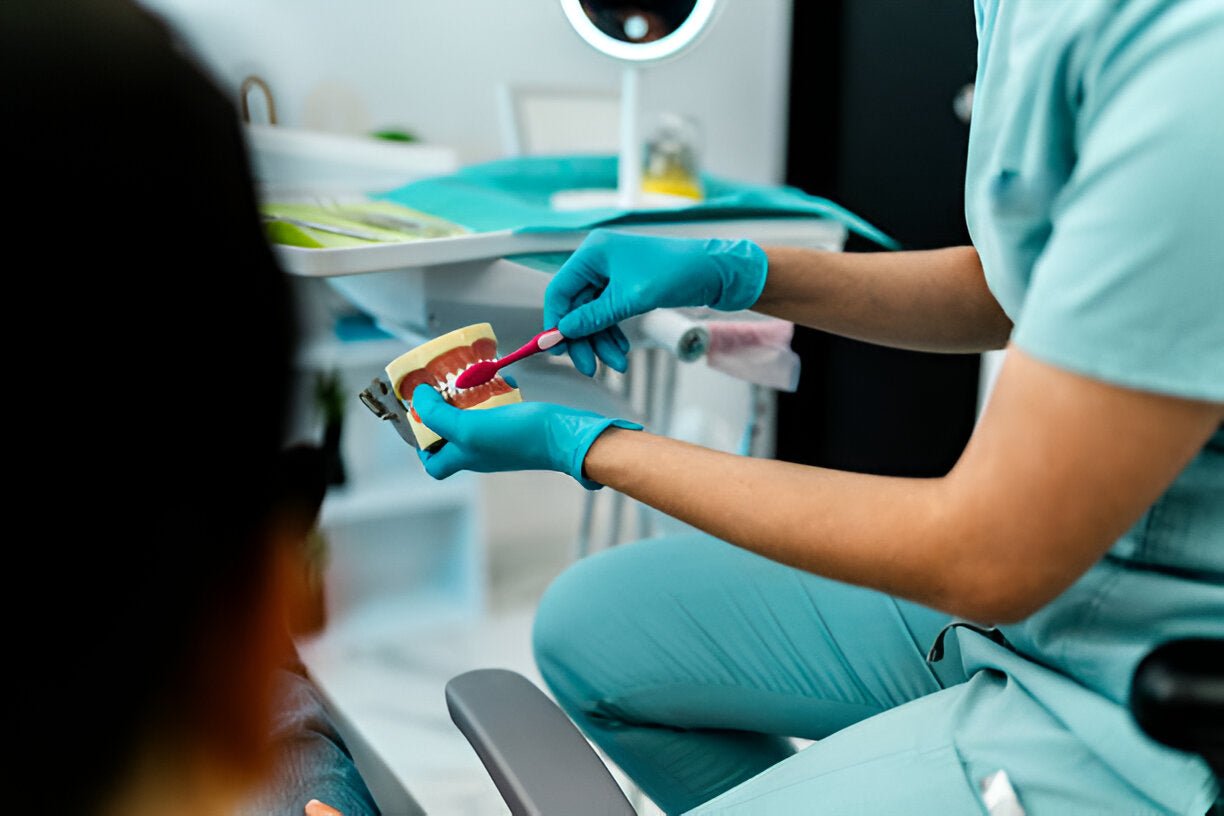Periodontal Maintenance:
Everything You Need to Know
Much like caring for your garden ensures its growth, making regular visits to your dental hygienist is essential for maintaining excellent oral health.
Yet, each garden plant needs different care, much like how gingivitis requires specialized treatment.
For instance, standard cleaning and periodontal cleaning are in the same category when discussing routine cleaning. However, each treatment differs in nature and scope.
While the former serves as a preventive measure, the latter is administered as a prescribed treatment.
Recognizing these nuances not only saves you time and resources. But it also allows you to focus on the precise care required, leading to more efficient and effective dental visits.
If you’re advised to undergo periodontal maintenance, here’s everything you need to know about the process.
Understanding periodontal maintenance
When tartar builds up more than four millimeters below the gum line, it can create pockets between the teeth and gums. These pockets can become a breeding ground for bacteria, leading to gum diseases like gingivitis. If left untreated, it can eventually progress to a higher form of gingivitis called periodontitis.
To stop gum disease from worsening, your periodontist might suggest periodontal maintenance. This could involve standard and specialized or deep teeth cleaning such as:
Teeth scaling
Teeth scaling is a deep-cleaning procedure that chips off hardened tartar from a patient's teeth surface. This treatment may require local anesthesia to numb the tooth area to keep you from feeling any pain.
Unlike routine cleaning that focuses on surface-level plaque, scaling goes below the gum line and tooth surfaces to remove plaque or tartar buildup.
Root planing
Root planing is a more intensive procedure often performed with scaling. It involves thoroughly cleaning the roots of teeth to remove plaque, tartar, and bacteria from below the gumline. Like teeth scaling, this treatment may also require using local anesthesia.
Regular teeth cleaning or prophylaxis
This procedure is typically recommended for individuals with good oral health. Regular cleanings are usually performed during routine dental checkups every six months.
Full mouth debridement
Gross debridement or also known as complete mouth debridement takes longer than a typical prophylaxis. A full mouth debridement aims to remove subgingival calculus or the harder-to-reach plaque below the surface of your gums.
You also have this so-called intensive debridement requiring a special electronic tool. This tool employs ultrasonic vibrations to break up calculus and remove plaque and biofilm retentive factors contributing to periodontal disease.

This is a common sign of periodontitis.Plaque buildup and bacterial infection are evident, contributing to the progression of the disease.
When is periodontal maintenance required?
Periodontal maintenance appointments are set up after a patient has been diagnosed with periodontal disease and has received root planing and scaling treatment.
If you've undergone periodontal treatments like scaling and root planing or gum surgery, periodontal maintenance is also essential to ensure their longevity. Routine cleanings help maintain the health of the treated areas and prevent relapse.
Deep teeth cleaning is usually recommended every three to four months. Why? It’s because it takes about three months for plaque bacteria to mature and cause gum disease.
Cleaning your teeth every three months removes these bacteria before they can harm your gums. This helps prevent gum disease and supports the healing of any existing gum issues.
Do patients with gum disease need periodontal maintenance forever?
As per the guidelines outlined in the Code on Dental Procedures and Nomenclature, this specific procedure is carried out after periodontal therapy and is intended to be ongoing throughout the lifespan of the teeth.
It suggests that the procedure is intended to be performed consistently and regularly as long as the teeth are in place.
How does periodontal maintenance work?
If you have a developing gum problem, it's essential to consult a periodontist or dental hygienist immediately.
Once you decide to visit your dentist, expect a series of ongoing dental procedures. By undergoing this dental plan, you will prevent gum disease from progressing, maintain gum health, and prevent tooth loss.
Regular dental visits
Periodontal maintenance begins by scheduling a regular dental appointment, followed by a series of dental visits, usually every three to four months. These visits are more frequent than regular dental checkups and cleanings.
Thorough examination
During each maintenance appointment, your dentist will comprehensively examine your gums, teeth, and oral tissues.
These examinations may involve measuring the depth of gum pockets and assessing the severity of gum disease.
Your periodontist will also identify any areas of concern, such as potential signs of gum inflammation or infections. The examination may also include using cone-beam CT imaging, intraoral radiographs, or X-rays to track early bone changes and diseases that cause local bone defects.
Professional cleaning
A crucial aspect of periodontal maintenance is professional cleaning. The dental professional will carefully remove accumulated plaque, tartar (calculus), and debris above and below the gum line.
Scaling and root planing may be performed if there's evidence of gum disease or pockets are deeper than usual. This involves thoroughly cleaning the root surfaces to remove bacteria and promote healing.
After cleaning your teeth, your dentist will use special tools to polish the surfaces of your teeth. This smooths the tooth surfaces and helps prevent plaque from adhering.
Personalized oral hygiene instructions
Your dental professional will guide proper oral hygiene techniques tailored to your needs. Dental recommendations may include the following:
- Brushing technique (e.g., using a soft-bristle toothbrush at a 45-degree angle to your gums)
- Interdental cleaning (e.g., the correct sizing of interdental brushes according to the spacing between teeth)
- Antimicrobial rinse
- Tongue cleaning
- Avoiding tobacco products
- Healthy diet
- Hydration
- Stress management
- Medications
Modification of treatment plan
If there are signs of disease progression or other issues, the treatment plan may be adjusted to ensure your oral health is effectively managed.
Continued monitoring
Regular periodontal maintenance appointments allow dental professionals to monitor your gum health closely over time. Consistency in these visits helps prevent further deterioration and catch problems early.
Collaborative care
Effective periodontal maintenance involves a partnership between you and your dental team. Following your dentist's recommendations for home care and attending scheduled appointments is essential for optimal results.

Before, teeth exhibit visible plaque buildup, discoloration, and minor stains. After cleaning, teeth appear noticeably brighter, with a smooth and polished surface, free from plaque and stains. Gums also appear healthier and pink in color.
Frequently asked questions
When is regular cleaning recommended over scaling?
If gum disease is detected in its early stages without causing harm to the structures beneath the gum line, professional cleaning may be recommended. However, scaling and root planing might be necessary if there are deeper pockets between your gums and teeth.
Can you alternate between routine teeth cleaning and periodontal maintenance?
Alternating between periodontal maintenance and prophylaxis every three months is unsuitable because regular cleanings are non-therapeutic. Patients who try to switch between prophylaxis and periodontal maintenance every three months won't experience the same long-lasting positive outcomes.
Can I eat after periodontal cleaning?
Once your numbness disappears and you can feel your tongue and lips again, you can start eating, which might take a few hours. Just be careful about what you eat while healing – we don't want anything like popcorn or hard foods to get stuck in your gums.
Does deep cleaning hurt?
Although deep teeth cleaning can cause discomfort, you shouldn't feel too much pain because of anesthesia. But you might still feel a bit sensitive afterward, with some swelling and bleeding.
How long does it take for gums to heal after deep teeth cleaning?
Your gums will start healing and reattach to your teeth a week after deep cleaning. Any initial discomfort should be gone. It might take 6 to 8 weeks to recover fully and complete reattachment, but you can usually eat, drink, brush, and floss again within the first week.
You can help your gums heal by rinsing your mouth twice to thrice daily with warm salt water or antimicrobial mouthwash. But remember not to strain yourself during the healing process. Take a few days to rest and let your mouth recover.
Consult a periodontist in Culver City
In your journey to maintain optimal oral health, the guidance of a skilled periodontist can make all the difference.
United Dental Care provides top-notch periodontal care to individuals in Culver City, Marina del Rey, Inglewood, and beyond.
Our expert team is here to support your gum health every step of the way. Don't wait – focus on a healthier smile.
Schedule your appointment with our experienced periodontist. Your gums deserve the best!




 By:
By: 

